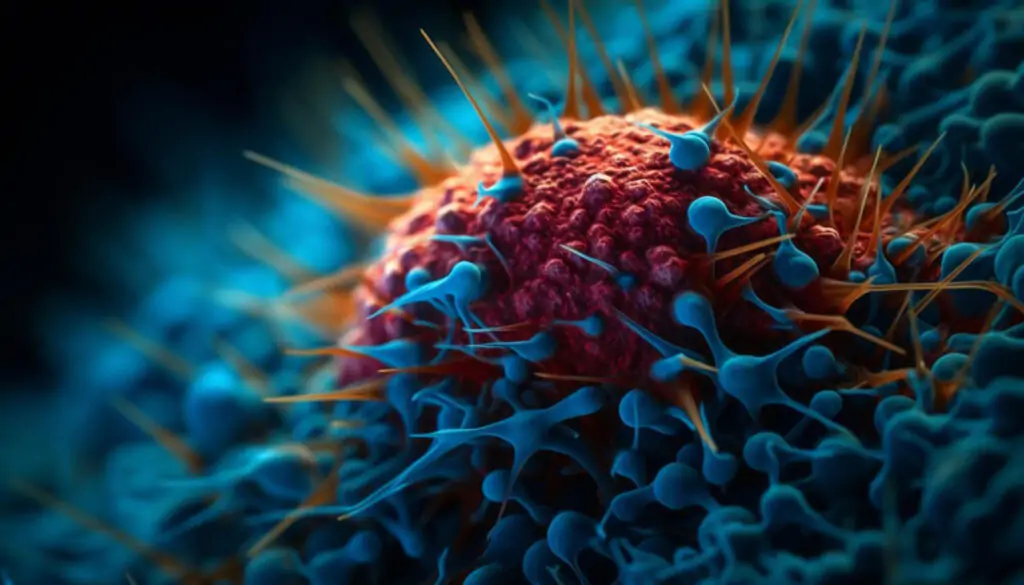Introduction
Based on the latest research, cancerous colon cells activate the SOX17 gene, which helps them grow into more advanced tumours to prevent detection.
Identifying and eliminating cells that are experiencing cancerous modifications is one of the immune system’s main responsibilities. However, only a few percent of cancer cells in their early stages are able to prevent detection and develop into more sophisticated tumours.
According to a recent study from MIT and the Dana-Farber Cancer Institute, there is one tactic that these precancerous cells use to evade immune recognition. The researchers discovered that cells that activate the SOX17 gene can virtually disappear from the immune system at the early stages of colon cancer development.
The researchers decide that if SOX17 function or the pathway it triggers could be blocked, it would provide a novel approach to treating early-stage malignancies before they spread to more extensive tumors.
Discovery of SOX17’s Role in Colon Cancer
An essential phase in protecting cancerous cells from the immune system during the early stages of colorectal cancer development is the activation of the SOX17 programme. One of the study’s senior authors, Omer Yilmaz, an associate professor of biology at MIT and a member of the Koch Institute for Integrative Cancer Research, shows that if the SOX17 programme can be inhibited, colon cancer may be better prevented, especially in patients who have a susceptibility to polyps in the colon.
The study’s senior author is Judith Agudo, an assistant professor at Harvard Medical School and main researcher at Dana-Farber Cancer Institute. It was just published in Nature. Norihiro Goto, a research scientist at MIT, is the main author of the work. Further collaborators include MIT postdoc Saori Goto in the Yilmaz lab, biology professor Tyler Jacks of MIT’s Koch Institute, and Peter Westcott, a former postdoc in the Jacks lab who is now an associate professor at Cold Spring Harbour Laboratory.
How Illuminated Growths Avoid Immune Recognition
Long-lived cells known as intestinal stem cells, whose function it is to continuously renew the lining of the intestines, are typically where colon cancer starts. During the course of their lengthy existence, these cells may get carcinogenic mutations that result in the development of polyps, a kind of premalignant growth that may ultimately develop into metastatic colon cancer.
To find out more about how these precancerous growths evade the immune system, the researchers used a technique they had previously developed for growing microscopic colon tumours in a lab dish and implanting them into mice. In this instance, the scientists genetically modified the tumors to express mutant forms of the cancer-associated genes Kras, p53, and APC, which are frequently seen in colon cancers in humans.
Researchers saw a significant increase in the tumours’ expression of SOX17 after implanting these tumours in mice. This gene generates a transcription factor that usually only becomes active throughout the initial stages of embryonic development, assisting in regulating the development of the intestines and the formation of veins.
The results of the researchers’ trials showed that SOX17 helps cancer cells develop an environment that is immunosuppressive when it is activated. Among its effects is the inhibition of cell synthesis of the receptor ordinarily responsible for detecting interferon gamma, a chemical that serves as one of the main tools used by the immune system to combat cancer cells.
Cancerous and precancerous cells can simply disregard immune system signals that would ordinarily instruct them to undergo programmed cell death if they did not have such interferon gamma receptors.
One of the primary functions of SOX17 is to inhibit the interferon gamma signaling pathway in precancerous adenoma and colorectal cancer cells. According to Yilmaz, tumour cells can proliferate in the presence of the immune system by blocking interferon gamma receptor signalling, which makes the tumour cells invisible to T cells.
Cancer cells also reduce the amount of MHC proteins they produce, which are crucial for alerting the immune system to malignant antigens, when interferon gamma signalling is absent. Because the cells are not sensitive to interferon gamma, they are also unable to produce chemokines, which are immunological chemicals that ordinarily attract T cells to aid in the destruction of malignant cells.
SOX17 as a Target for Cancer Treatment in the Early Stages
The immune system was able to combat colon tumour organoids that had SOX17 deleted far more successfully when the researchers put those organoids into mice. This implies that a potential treatment for colon cancer in its early stages might involve blocking cancer cells’ ability to switch off SOX17.
According to Goto, “we were able to essentially obliterate the ability of these tumour cells to persist just by turning off SOX17 in fairly complex tumours.”
In order to complete their investigation, the scientists also examined patient gene expression data. What they discovered was that, although SOX17 was often strongly expressed in early-stage colon cancers, its expression decreased as the tumours grew more invasive and metastasized.
According to Yilmaz, “we think this makes a lot of sense because there are other mechanisms that create an immunosuppressive environment as colorectal cancers become more invasive and metastatic.” “Sox17 becomes less important as colon cancer becomes more aggressive and activates these other mechanisms.”
Because transcription factors like SOX17 are thought to be challenging to target with medications due in part to their chaotic structure, the researchers now intend to find other proteins with which SOX17 interacts in the hopes that blocking some of those connections may be simpler.
Additionally, the researchers intend to look into the mechanism that activates SOX17 in precancerous cells.
The study was supported by grants from the Koch Institute-Dana Farber Harvard Cancer Centre Bridge Project, the National Institutes of Health/National Cancer Institute, and the MIT Stem Cell Initiative through Foundation MIT.
Conclusion
The comprehension of how precancerous cells avoid immune detection and develop into advanced tumours has advanced considerably with the identification of the SOX17 gene’s involvement in colon cancer. These cells produce an immunosuppressive environment by turning on the SOX17 programme, which successfully hides them from the immune system’s monitoring systems. This finding opens new avenues for ability-based remedies focused on SOX17 that may save you from developing early-stage colon cancer. Further studies are needed to discover the mechanisms behind SOX17 activation and its interactions with different proteins, paving the way for modern healing techniques in the fight against most cancers.
FAQ's
Q: What is SOX17, and why is it significant in colon cancer?
A: SOX17 is a gene that, when activated in precancerous colon cells, allows them to elude immune detection and develop more advanced tumours. Understanding its involvement reveals prospective therapy options for early-stage colon cancer.
Q: How was the role of SOX17 in colon cancer discovered?
A: Researchers from MIT and the Dana-Farber Cancer Institute used rodent models and patient gene expression information to evaluate SOX17’s position in most colon cancers. They observed that SOX17 activation generates an immunosuppressive environment, which lets in cancer cells to elude immune identification.
Q: What are the implications of inhibiting SOX17 in colon cancer treatment?
A: By increasing the susceptibility of cancer cells to immunological recognition and elimination, SOX17 inhibition can be able to prevent the advancement of early-degree colon cancers. This creates new possibilities for SOX17, which focuses on healing processes within the struggle against most colon cancers.
Q: What are the future research directions in this field?
A: Subsequent investigations will raise awareness about comprehending the techniques that cause SOX17 activation in precancerous cells and pinpointing capability restoration goals. Furthermore, investigating SOX17’s interactions with different proteins should bring about the introduction of stronger colon cancer remedy plans.




